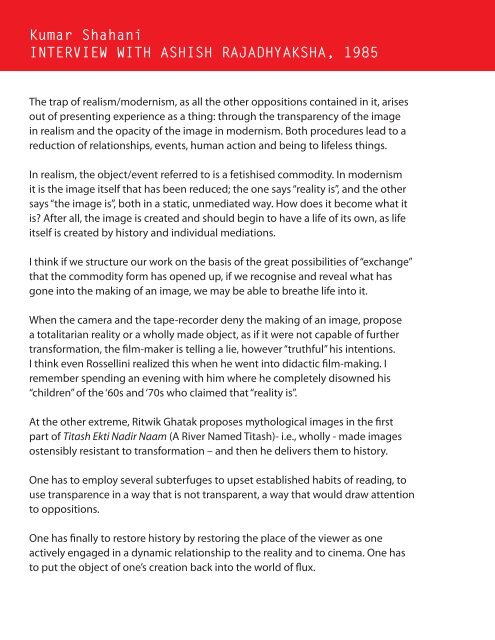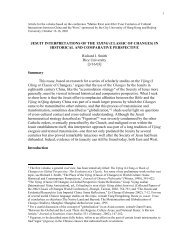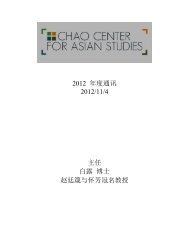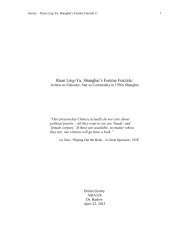Festival Brochure (Downloadable PDF) - Chao Center for Asian ...
Festival Brochure (Downloadable PDF) - Chao Center for Asian ...
Festival Brochure (Downloadable PDF) - Chao Center for Asian ...
- No tags were found...
Create successful ePaper yourself
Turn your PDF publications into a flip-book with our unique Google optimized e-Paper software.
Kumar ShahaniINTERVIEW WITH ASHISH RAJADHYAKSHA, 1985The trap of realism/modernism, as all the other oppositions contained in it, arisesout of presenting experience as a thing: through the transparency of the imagein realism and the opacity of the image in modernism. Both procedures lead to areduction of relationships, events, human action and being to lifeless things.In realism, the object/event referred to is a fetishised commodity. In modernismit is the image itself that has been reduced; the one says “reality is”, and the othersays “the image is”, both in a static, unmediated way. How does it become what itis? After all, the image is created and should begin to have a life of its own, as lifeitself is created by history and individual mediations.I think if we structure our work on the basis of the great possibilities of “exchange”that the commodity <strong>for</strong>m has opened up, if we recognise and reveal what hasgone into the making of an image, we may be able to breathe life into it.When the camera and the tape-recorder deny the making of an image, proposea totalitarian reality or a wholly made object, as if it were not capable of furthertrans<strong>for</strong>mation, the film-maker is telling a lie, however “truthful” his intentions.I think even Rossellini realized this when he went into didactic film-making. Iremember spending an evening with him where he completely disowned his“children” of the ‘60s and ‘70s who claimed that “reality is”.At the other extreme, Ritwik Ghatak proposes mythological images in the firstpart of Titash Ekti Nadir Naam (A River Named Titash)- i.e., wholly - made imagesostensibly resistant to trans<strong>for</strong>mation – and then he delivers them to history.One has to employ several subterfuges to upset established habits of reading, touse transparence in a way that is not transparent, a way that would draw attentionto oppositions.One has finally to restore history by restoring the place of the viewer as oneactively engaged in a dynamic relationship to the reality and to cinema. One hasto put the object of one’s creation back into the world of flux.








